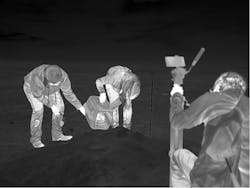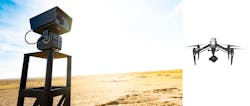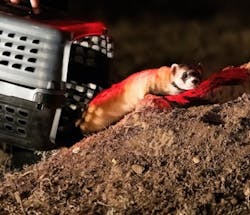Thermal imaging aids wildlife conservation efforts
Teledyne FLIR (Wilsonville, OR) has joined forces with the World Wildlife Fund (WWF; Washington, DC) to protect struggling habitats and endangered wildlife—specifically, the black-footed ferret (see video).
“Black-footed ferrets are one of North America’s most endangered mammals,” says Kristy Bly, senior wildlife conservation biologist for WWF's Northern Great Plains Program and manager of the black-footed ferret restoration work. Hundreds of thousands of these masked bandits of the prairie once roamed the plains of central North America, but by the late 1970s, they were on the brink of extinction.
The U.S. Fish and Wildlife Service captive breeding program saved them in the 1980s, but they’ve remained endangered ever since. The primary constraint to the animal’s recovery is the sylvatic plague, a non-native lethal bacteria carried by fleas that then infect ferrets and their main source of food: prairie dogs. Disease mitigation efforts allowed the ferrets to be reintroduced at the Fort Belknap Reservation in Montana, which is where the WWF-led team is focusing its conservation efforts.
The team is using Teledyne FLIR’s Tau 2 OEM thermal camera built into a pan-tilt camera unit (see Fig. 1). It’s fitted with a 100 mm telephoto lens for long-distance imaging and a 4x continuous zoom. This longwave-infrared camera boots up to show an image in less than four seconds and can resolve temperature contrast as small as <0.05°C, explains Teledyne FLIR’s Mary Betty Taylor. “This means researchers can easily see the higher body temperature of a black-footed ferret against the warm backdrop of an underground burrow entrance.”
Black-footed ferrets are nocturnal, burrow-dwelling animals, so detection without thermal imaging is a challenge. High-intensity spotlights mounted to truck windows or roofs are used to search for those living in prairie dog colonies by looking for their tell-tale emerald-green eyeshine. This technique has been effective, but relies heavily on field capacity and unobstructed views—and observers must move constantly to bring new areas into view.
Another challenge in finding these ferrets is they often shy away from lights and truck sounds, further inhibiting the ability to estimate population numbers. “Thermal infrared cameras are an effective tool in the ferret detection toolbox, as they sense infrared radiation (body heat) of an individual,” Bly says.
The tower-mounted thermal camera is effective at identifying black-footed ferrets from other animals such as rabbits, badgers, and coyotes. It also detects ferrets at a similar distance to truck roof-mounted spotlights, which is about 200 to 400 meters. The camera can detect the ferrets when spotlight observers miss them.
The WWF-led team is also using a drone camera in its efforts—Teledyne FLIR’s Zenmuse XT2, featuring the same Tau 2 sensor used in the tower-mounted pan-tilt camera (see Fig. 2). Its high sensitivity, telephoto field of view, and zoom capabilities make this a good choice for pinpointing small mammals in the dark. The drone’s camera also features a 30 Hz refresh rate, which allows it to transmit a smooth video stream back to the operator’s monitor.“With both thermal cameras in play, researchers can search wide areas from above for signs of a black-footed ferret,” Taylor says. “Once the drone finds a potential target, they can use the tower-mounted thermal camera to verify they’re looking at a black-footed ferret and not, say, a prairie dog. This is much more efficient than driving across the prairie and sweeping a spotlight over wide areas in the hope of catching eyeshine from a ferret who happens to be looking in the right direction.”
To effectively design conservation interventions and reach the wildlife recovery goal, biologists need to annually estimate the size and health of existing ferret populations. Forward-looking infrared technologies are an effective tool in these efforts.
“The Teledyne camera system is ideal for locating ferrets in remote areas that are hard to traverse with a truck and to obtain estimates of the number of kits in each litter,” Bly says. “The drone-mounted camera is effective at locating ferrets particularly when they are moving across portions of their territories. This system has the greatest spatial coverage of ferret habitat.”
Once a ferret and/or its burrow is located, humane traps are set up in the area. Trapped ferrets are then retrieved by biologists and taken to a mobile lab, where there is equipment for administering anesthesia and performing vaccinations. Tracking chips are also inserted in each animal, allowing biologists and conservationists to monitor the species’ progress. Upon recovering from this process, the ferrets are carefully placed back in their burrows (see Fig. 3).The WWF team’s next steps for the recovery program will be to transition from testing the tower- and drone-mounted thermal camera systems to using them operationally as part of annual ferret monitoring occurring between August and October 2023 at Fort Belknap.
“In tandem with spotlight crews, we will use the tower-mounted camera system to obtain estimates of the number of ferret kits in each litter and the drone camera system to detect ferrets in remote areas,” Bly says. “The road to ferret recovery is long, but it’s possible with investments in thermal camera technologies that advance our ability to accurately detect and protect them in the wild.”
This thermal imaging technology could also help detect and advance recovery efforts for other wildlife species, and potentially be used to combat animal poaching in protected areas.
About the Author
Justine Murphy
Multimedia Director, Digital Infrastructure
Justine Murphy is the multimedia director for Endeavor Business Media's Digital Infrastructure Group. She is a multiple award-winning writer and editor with more 20 years of experience in newspaper publishing as well as public relations, marketing, and communications. For nearly 10 years, she has covered all facets of the optics and photonics industry as an editor, writer, web news anchor, and podcast host for an internationally reaching magazine publishing company. Her work has earned accolades from the New England Press Association as well as the SIIA/Jesse H. Neal Awards. She received a B.A. from the Massachusetts College of Liberal Arts.



